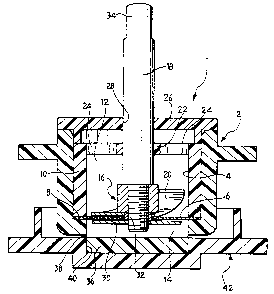Some of the information on this Web page has been provided by external sources. The Government of Canada is not responsible for the accuracy, reliability or currency of the information supplied by external sources. Users wishing to rely upon this information should consult directly with the source of the information. Content provided by external sources is not subject to official languages, privacy and accessibility requirements.
Any discrepancies in the text and image of the Claims and Abstract are due to differing posting times. Text of the Claims and Abstract are posted:
| (12) Patent: | (11) CA 2171117 |
|---|---|
| (54) English Title: | A MECHANICAL TRITURATOR FOR BIOLOGICAL MATERIAL |
| (54) French Title: | TRITURATEUR MECANIQUE POUR MATERIAUX BIOLOGIQUES |
| Status: | Expired and beyond the Period of Reversal |
| (51) International Patent Classification (IPC): |
|
|---|---|
| (72) Inventors : |
|
| (73) Owners : |
|
| (71) Applicants : |
|
| (74) Agent: | MACRAE & CO. |
| (74) Associate agent: | |
| (45) Issued: | 2004-11-23 |
| (86) PCT Filing Date: | 1994-09-26 |
| (87) Open to Public Inspection: | 1995-04-06 |
| Examination requested: | 2001-06-28 |
| Availability of licence: | N/A |
| Dedicated to the Public: | N/A |
| (25) Language of filing: | English |
| Patent Cooperation Treaty (PCT): | Yes |
|---|---|
| (86) PCT Filing Number: | PCT/EP1994/003202 |
| (87) International Publication Number: | WO 1995009051 |
| (85) National Entry: | 1996-03-05 |
| (30) Application Priority Data: | ||||||
|---|---|---|---|---|---|---|
|
A mechanical triturator for biological mate-
rial comprises a cylindrical housing (2) defining a
chamber (4) in which a cutting member (6) con-
stituted by a perforated plate is disposed. A rotor
member (16), mounted for rotation in the chamber
(4), has a screw (20) which cooperates with the cut-
ting member (6) in order, as a result of its rotation,
to supply the biological material into contact with
the cutting member (6) and to cause the trituration
thereof.
Un triturateur mécanique pour matériaux biologiques comprend un carter cylindrique (2) délimitant une chambre (4) dans laquelle est disposé un élément coupant (6) constitué d'une plaque perforée. Un rotor (16), monté rotatif dans la chambre (4), est doté d'une vis (20) qui coopère avec l'élément coupant (6), de manière que, par suite de la rotation du rotor, cette vis apporte des matériaux biologiques jusqu'à ce qu'ils viennent au contact de l'élément coupant (6) et provoque ainsi la trituration de ceux-ci.
Note: Claims are shown in the official language in which they were submitted.
Note: Descriptions are shown in the official language in which they were submitted.

2024-08-01:As part of the Next Generation Patents (NGP) transition, the Canadian Patents Database (CPD) now contains a more detailed Event History, which replicates the Event Log of our new back-office solution.
Please note that "Inactive:" events refers to events no longer in use in our new back-office solution.
For a clearer understanding of the status of the application/patent presented on this page, the site Disclaimer , as well as the definitions for Patent , Event History , Maintenance Fee and Payment History should be consulted.
| Description | Date |
|---|---|
| Time Limit for Reversal Expired | 2009-09-28 |
| Letter Sent | 2008-09-26 |
| Grant by Issuance | 2004-11-23 |
| Inactive: Cover page published | 2004-11-22 |
| Inactive: Final fee received | 2004-09-15 |
| Pre-grant | 2004-09-15 |
| Notice of Allowance is Issued | 2004-05-19 |
| Letter Sent | 2004-05-19 |
| Notice of Allowance is Issued | 2004-05-19 |
| Inactive: Approved for allowance (AFA) | 2004-05-11 |
| Amendment Received - Voluntary Amendment | 2004-04-13 |
| Inactive: S.30(2) Rules - Examiner requisition | 2003-10-14 |
| Amendment Received - Voluntary Amendment | 2001-11-20 |
| Inactive: Application prosecuted on TS as of Log entry date | 2001-08-20 |
| Letter Sent | 2001-08-20 |
| Inactive: Status info is complete as of Log entry date | 2001-08-20 |
| All Requirements for Examination Determined Compliant | 2001-06-28 |
| Request for Examination Requirements Determined Compliant | 2001-06-28 |
| Application Published (Open to Public Inspection) | 1995-04-06 |
There is no abandonment history.
The last payment was received on 2004-08-04
Note : If the full payment has not been received on or before the date indicated, a further fee may be required which may be one of the following
Please refer to the CIPO Patent Fees web page to see all current fee amounts.
| Fee Type | Anniversary Year | Due Date | Paid Date |
|---|---|---|---|
| MF (application, 3rd anniv.) - standard | 03 | 1997-09-26 | 1997-08-01 |
| MF (application, 4th anniv.) - standard | 04 | 1998-09-28 | 1998-07-29 |
| MF (application, 5th anniv.) - standard | 05 | 1999-09-27 | 1999-08-04 |
| MF (application, 6th anniv.) - standard | 06 | 2000-09-26 | 2000-07-27 |
| Request for examination - standard | 2001-06-28 | ||
| MF (application, 7th anniv.) - standard | 07 | 2001-09-26 | 2001-07-26 |
| MF (application, 8th anniv.) - standard | 08 | 2002-09-26 | 2002-08-08 |
| MF (application, 9th anniv.) - standard | 09 | 2003-09-26 | 2003-07-28 |
| MF (application, 10th anniv.) - standard | 10 | 2004-09-27 | 2004-08-04 |
| Final fee - standard | 2004-09-15 | ||
| MF (patent, 11th anniv.) - standard | 2005-09-26 | 2005-08-17 | |
| MF (patent, 12th anniv.) - standard | 2006-09-26 | 2006-08-17 | |
| MF (patent, 13th anniv.) - standard | 2007-09-26 | 2007-08-15 |
Note: Records showing the ownership history in alphabetical order.
| Current Owners on Record |
|---|
| CONSUL T.S. S.R.L. |
| Past Owners on Record |
|---|
| GIANMARCO ROGGERO |